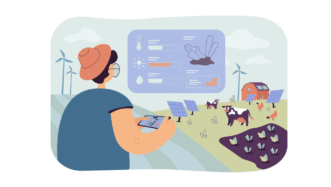LESSON OVERVIEW
In this lesson plan on extinction, students will learn a lot of related vocabulary, watch a video featuring David Attenborough and work on a group project on the protection of wildlife.
C1 / Advanced75 minFlipped LessonUnlimited Plan
This is a Flipped Classroom lesson plan. In a nutshell, it means that the first part of the lesson needs to be done by students at home. Learn more about flipped classroom and how we implement it in these lesson plans in our post.
PRE-CLASS ACTIVITIES
The pre‐class worksheet starts with a vocabulary task. First, students get a list of sentences that they need to complete by choosing the correct words. Next, working on the same sentences, they have to find the synonyms of words such as protect, protection, unspoiled, etc. Thanks to these two activities, students will learn a lot of vocabulary connected with nature, e.g. extinction, species, wildlife, biodiversity, habitat, etc.
IN-CLASS ACTIVITIES
Intro
This part of the lesson plan starts with a pronunciation task. Students have to repeat after a teacher the list of words (including commonly mispronounced words such as wilderness or species). Next, they discuss the questions which check whether they know who David Attenborough is.
Listening comprehension (video) and group project
When it comes to the first listening comprehension task, students just watch the first part of the video and summarize what crisis David Attenborough and other speakers talk about. Before watching the second part, they have to brainstorm the ways humans destroy ecosystems. Then, they watch the second part and do a true or false exercise. Again, before watching the last part of the video (comprehension questions), students brainstorm the ways we can safeguard our planet. Next, students complete and discuss some statements connected with the protection of our planet. This lesson plan on extinction ends with the wildlife project. Students work in pairs or groups and come up with a small local initiative that could help protect wildlife. Finally, they share their initiative with the whole class. Encourage other students to comment on the initiatives of other groups.
WORKSHEETS
Subscribe to unlock these and many other Standalone lesson lesson plans with the Unlimited plan
Subscribe














Very well designed, engaging and So complete! Thank you!
Thank you for such positive feedback 🙂
Thank you very much for of your lessons, they are real life savers, engaging and very well designed!
Stephanie, thank you! We’re happy that you find them useful and interesting 🙂
Great lesson plan, thank you! Although I have a question – why did you include a pronunciation exercise for the lesson designed for C1 level? Most likely the majority of students would be familiar with these words + these words don’t have any weird pronunciation rules imho
Just curious, since I don’t have much of experience and thought there is some methodological explanation
Hi Katerina! Thank you for taking the time to comment! I’m glad you like the lesson 🙂
Regarding the pronunciation task, I included it in the worksheet as the words were always somehow confusing for my students. For example, wild /waɪld/, but wilderness /ˈwɪl.də.nəs/; consume /kənˈsjuːm/, but /kənˈsʌmp.ʃən/. I also feel that the prefixes ‘bio-‘ and ‘eco-‘ are present in many languages, but are pronounced differently than in English. I hope my explanation helps 🙂
Thank you for your explanation, Justa! 🙂